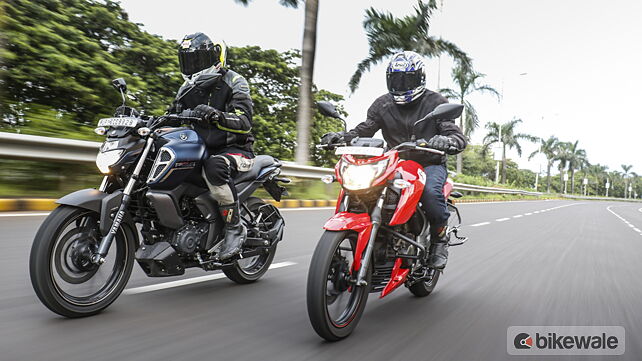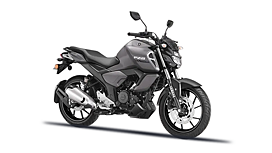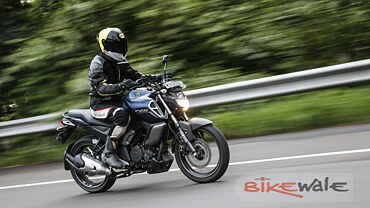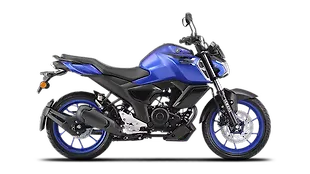Introduction

The Yamaha FZ and the TVS Apache have been arch-rivals for more than 10 years now. These bikes were introduced in the market at a time when the space for performance-oriented motorcycles was growing strong and at a fast pace. While the Apache was touted to follow the bloodline of its racing pedigree and the innovation that TVS was famous for, the FZ was acclaimed as the ‘Lord of the Streets’, offering refinement, quality and handling from the Japanese two-wheeler giant.
Fast forward to the present where both motorcycles, in their latest forms, continue to clash against one another for bragging rights. They have evolved in terms of form and function, giving them much to brag about. So, will the Apache RTR 160 4V or will the FZ S V3.0 claim top honours in this comparison? Let’s find out.
Looks & Styling

It would be wrong to call either of the bikes better than the other. That’s because the overall design has progressed well while retaining the core design aspects. In the case of FZ S V3, the motorcycle has a distinctive commanding stance due to its wide handlebar, thick front forks and now pronounced fuel-tank extensions. The headlamp unit remains compact in dimensions but carries a more sculpted look.
Furthermore, the bike comes with additional extensions to the lower side of the tank extensions and a chunky underbelly that together give the FZ S V3 a beefy appeal. The tail, however, carries a minimalistic look with hardly any presence of body-coloured panels giving an impression that Yamaha forgot to add some muscle at the back. Besides that, the motorcycle gets a re-designed stubby exhaust and a new set of split-type five-spoke alloy wheels that look nicer.

The Apache RTR 160 4V, on the other hand, is a better-proportioned motorcycle with a sculpted design that is sharp and fierce. It has the sporty street bike appeal that reeks of aggression with an inclination towards its racing roots. It has a slightly larger bikini fairing covering the top side of the front forks, a muscular tank design wherein the body line extends ahead as tank extensions, sharp-looking body-coloured underbelly and a proportionally carved tail section.
Besides that, TVS has slapped on a chequered flag graphic on the fuel tank reminding us again about the Apache’s racing origins and a contrast coloured body panel running across the spine of the tank. The Apache RTR 160 comes shod with sporty six-spoke alloy wheels that are accompanied by a compact double-barrel exhaust canister.
Ergonomics & Quality

Over here, the Apache gets our vote for offering better ergonomics and also in terms of build quality. Both bikes have an upright riding stance with slightly rear-set foot-pegs. But, the TVS is better with its well-cushioned seat and easy to reach handlebar. We would like to particularly mention the seat since, after riding both bikes back-to-back for a long duration, the Apache’s seat didn’t leave us with sore buttocks as compared to the FZ. It was more on the firmer side that required one to shift weight on the seat more often.
Coming to build quality, the Apache hands-down comes with better materials and plastic that render a premium sense on touch and feel. The switchgear has a long-lasting feel while the body panels seem to have better resistance to fading and scratches. Other highlights include the brushed finish levers, cast brake and gear change pedals.

The FZ has exposed Allen bolts along the spine of the fuel tank that looks crude. Besides the matte paint finish for the body panel, Yamaha has also made extensive use of matte plastic cladding that tends to gets soiled very soon and is easily prone to scratches. Furthermore, while the switchgear gets the job done, it fails to provide that up-market feel. Also, the incorporation of the pass switch with the high and low beam switch does take time to get accustomed to.
Features & Technology

Over here, both motorcycles feature full digital instrumentation that have their advantages. The Apache gets an Amber colour backlit display that displays the speed, revs, time, fuel level, shift light, odometer and trip meter (Fuel-injected variant gets a white backlit display from the 200 featuring additional bits like gear position indicator, top speed and acceleration recorder, lap timer and low-fuel trip mode).
In the case of the FZ, the motorcycle packs a negative digital display that looks nicer but is rather small in size. The display features a tachometer, speedometer, fuel gauge, odometer and two trip meters. It is surrounded by tell-tale lights on either side for other information.

The FZ packs a full-LED headlamp (halogen pilot lamp) which has become a popular feature for motorcycles in the segment. Besides that, the tail lamp and turn indicators remain the conventional filament type. For the Apache, TVS has retained the conventional halogen bulb layout for the headlamp and turn indicators but updated the tail lamp unit with a grid of LED lights.
Engine & Performance

The Yamaha boosts of a 149cc single-cylinder mill that registers 13bhp at 8,000rpm and 12.8Nm at 6,000rpm. The TVS, on the other hand, packs a 159.7cc single-pot mill that churns out 16.1bhp at 8,000rpm and 14.8Nm at 6,500rpm. Both come mated to a five-speed gearbox. Add to this mix the kerb weight of both bikes - 132kg for the FZ and 143kg for the Apache.
With these figures, and despite the additional weight, the Apache is capable of attaining a higher top speed compared to the FZ. If you drag race the two, then up to 80-90kmph both bikes remain side by side, beyond which, the TVS starts to pull ahead, leaving the FZ behind.

Now the Apache revs higher and also churns out more power and torque but, in terms of refinement, it is the FZ that won our hearts. The vibrations felt at the handlebar, footpegs and seat is less making it feel more relaxed and smooth. Also, the power and torque curves are stronger in the low- and mid-section of the rev range which makes the FZ S V3 a better bike in traffic. With more usable torque at disposal, the need to change gears doesn’t arise that often as compared to the RTR 160.
Ride & Handling

Until now, the Apache had been comfortably leading the competition but it's over here where the FZ fills the gap. Now, these bikes are not meant for drag, are they? Instead, they are expected to make weaving through traffic as easy as a knife slicing through butter and maintain balance like a ballerina on her toes. And the FZ ticks these boxes is if it was born to do this. The FZ has a shorter wheelbase of 1330mm compared to the Apache at 1357mm. Add a smaller turning radius to it and what you get is the ideal formula to get past through traffic.
Both motorcycles have similar suspensions, telescopic forks up front and a monoshock at the rear. However, the FZ has a slightly stiffer setup that aids in making clean and quick lane changes while corners can be attacked with more speed and confidence. The RTR 160, despite its sporty character, turned out to be more easy-going with frequent steering inputs needed on switching lanes and the not-so-welcoming feedback when it came to cornering.

And when the time comes to drop the anchors, the FZ outshined the RTR 160 by a huge margin. The bite from the FZ’s brakes is strong and can be modulated with ease depending on the road conditions. The feedback from the RTR 160’s brakes, especially the front lever, feels spongy. Sure, there is a bite when you squeeze them further, but that period of braking feels fairly long and does little to improve one’s confidence levels.
Fuel Efficiency

Being premium performance-oriented commuters in the 150cc-160cc segment, both bikes returned decent fuel economy figures. While the Apache RTR 160 returned 44kmpl, the FZ S V3 returned a marginally higher 44.2kmpl. With those figures, the RTR 160 (12-litre fuel tank) will offer a range of 528kms while the FZ S V3 (12.8-litre fuel tank) will offer a range of 565kms before the tank runs dry.
Price and Warranty

The RTR 160 4V you see here, is the carb version, which retails at Rs 93,101 while the top-spec fuel-injected variant retails at Rs 99,101. The FZ S V3.0 available in only the fuel-injected form carries a sticker price of Rs 98,180. In terms of the warranty, the TVS offers five years or 60,000kms coverage, while Yamaha offers only two years or 30,000kms coverage.
Verdict

Both motorcycles have massively evolved in terms of innovation, design, performance and ergonomics which has made them better products overall and also tougher to choose a winner. After tallying the score chart, the FZ S V3.0 has emerged as the winner by a very narrow margin.
Yes, it is slower, has a stiff seat, simpler instrument console and questionable quality standards, but apart from that, it excels in other aspects that matter when considering a performance-oriented commuter. It has the acute handling properties and a huge chunk of torque that is concentrated in that part of the rev-range which is crucial while commuting.
As for the RTR 160, we still feel that it is a good motorcycle. You can very much live with it on a day to day basis. It has interesting features and a powerful motor that will keep you in the lead after other 150cc bikes have exhausted their power. And if that’s what rocks your boat, you can consider it. But again, Yamaha calls the FZ as the ‘Lord of the Streets’ and it rightfully remains so.
Photography by Kapil Angane
Final Score
| Parameters | Max Points | Yamaha FZ S V3.0 | TVS Apache RTR 160 4V |
| Rank | - | 1 | 2 |
| Looks & styling | 10 | 6 | 6 |
| Ergonomics & Quality | 10 | 5 | 6 |
| Features & Tech | 10 | 6 | 6.5 |
| Engine & Gearbox | 10 | 5.5 | 5 |
| Performance | 10 | 6.5 | 7 |
| Ride Quality | 10 | 6 | 6.5 |
| Handling & Braking | 10 | 7.5 | 5.5 |
| Fuel Efficiency | 10 | 6.5 | 6.5 |
| Price & Warranty | 10 | 6 | 6 |
| Desirablility | 10 | 7 | 5 |
| Total | 100 | 62 | 60 |
Specifications
| Make | Yamaha | TVS |
| Model | FZ S V3.0 | Apache 160 4V |
| POWER TRAIN | ||
| Engine Type | Air-Cooled | Oil-cooled |
| Capacity | 149cc | 159.7cc |
| Max Power | 13bhp | 16.1bhp |
| Max Torque | 12.8Nm | 14.8Nm |
| Gearbox | 5-speed | 5-speed |
| Fuel Efficiency | 44.2kmpl | 44kmpl |
| CYCLE PARTS | ||
| Supension F | Telescopic | Telescopic |
| Suspension R | Monoshock | Monoshock |
| Brakes F | 282mm disc with ABS | 270mm disc with ABS |
| Brakes R | 220mm disc | 200mm disc |
| Tyre F | 110/80-R17 (Tubeless) | 90/90-R17 (Tubeless) |
| Tyre R | 140/60-R17 (Tubeless) | 130/70-R17 (Tubless) |
| MEASURES | ||
| Fuel Tank | 12.8 litres | 12 litres |
| Wheelbase | 1330mm | 1357mm |
| L x W x H | 1990mm x 770mm x 1030mm | 2050mm x 790mm x 1050mm |
| Kerb Weight | 132 kg | 143 kg |
Gallery
1/159
Yamaha-FZ-S-V3-TVS-Apache-RTR-160-4V-Action
Double Tap to Zoom















































![KTM 390 Adventure X [2025] KTM 390 Adventure X [2025]](https://imgd.aeplcdn.com/272x153/n/cw/ec/190885/390-adventure-x-2025-right-side-view.jpeg?isig=0&q=80)
